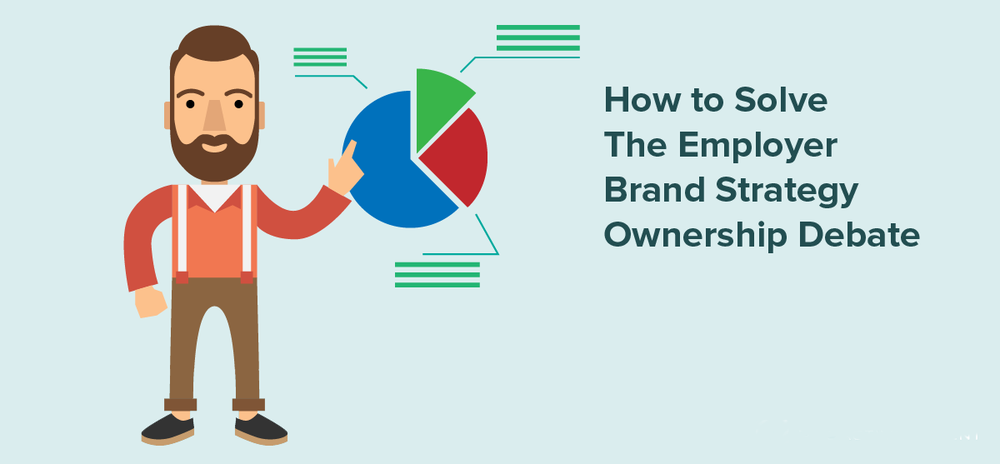
There is a reason that the employer brand ownership is a never-ending debate that has been a topic of concern. This has a lot to do to the lack of understanding behind who controls the brand of a company, both internal and external. For many organizations, employer branding is a shared responsibility managed between HR, Recruiting, Marketing and Internal Communications with an ultimate ownership by the CEO, who sets the tone for the company’s mission and values. But who ultimately owns it is a topic often up for debate.
The employer branding ownership debate is more about which department can be trusted with articulating and guiding the employee experience story and overall brand perceptions about the workplace (a skillset that historically has existed within marketing) as well as how firms are structured to manage and deal with these experiences and perceptions (a skillset that historically has existed within HR).
The Never-Ending Employer Branding Debate Isn’t As Simple As Ownership
Employer branding can either be a weak point or the strength of an organization. Right from managing the existing workforce to acquiring new talent as well as creating an effective work culture, employer branding comes into play in all these aspects. Recruitment, onboarding of new employees, internal communications, active engagement of the workforce and even consumer market perceptions are all affected either adversely or positively by employer branding.
Therefore, the answer to who owns employer branding is never clear cut for any organization and may be the wrong question to ask in the first place. I would argue that every single employee has the ability to affect the company’s employer brand and together should have “ownership” of it, but only one department is best positioned to affect the employee experiences and culture that shapes an employer brand and that's HR. So, perhaps the question shouldn’t be who “owns” employer branding but who “drives” it.
5 Ways To Implement Best Employer Branding Practices
1. HR Should Drive Employer Branding
From the CEO to the secretary, it is the entire workforce’s shared experiences that create the culture and ultimately the employer brand of an organization. HR should be armed with the tools they need to effectively work across the organization to drive employer branding. The full lifecycle of an employee from sourcing candidates to retirals, can be influenced positively or negatively by employer branding and this lifecycle for most organizations is driven by HR. The answer to this debate is to admit that the HR department is the team driving the employer brand. Providing the right resources, training, and creating the strategies to strengthen the practices and performance of the HR and recruiting staff around building and maintaining a strong employer brand should be the priority.
2. Question The Existing Employer Brand Ownership Practices
A few of the questions that should be asked include, how does employee branding affect the overall growth of the firm, what does the firm achieve by managing the employee brand, are the existing branding practices effective or do changes have to be made? A few additional questions include, how should the firm align between the employer brand and the consumer brand as well as who is responsible for the budget for providing training and acquire the needed tools for improved operations?
3. Build Trust and Network Access Across The Firm
Companies that are spread out at locations throughout the world should set goals of building trust between various vital departments as well as give these departments network access to help in improving communications. One of the important departments is undoubtedly HR as it touches every part of the organization, but others include marketing, communications and the legal departments. Collaboration between these business functions is vital for a strong employer brand strategy.
4. Include The Legal Team
While this is not acknowledged enough, the legal department is a crucial one as far as employee relations go, the legal department should be brought into confidence and be asked to create trademarks as well as employee policies around social media use and other communication policies that are fair, just and create a stronger work culture. They should approach communication policies first from a place of empowering employees with the information they need to avoid making legal mistakes and emphasize what they can do as well as what they can’t.
5. Understand The Shift In Tides
The world has changed since we once knew it to be centered around marketing. In today’s world two important factors matter, the first factor is consumers and the second factor is employees. While creating employer branding strategy best practices, some organizations are creating a unified system by merging internal communications with the employer branding section. At a previous company I worked at, we actually had internal communications reporting into HR rather than marketing and employer branding within the recruiting function of HR. This can help the firm put the brand above all else and build consistent communications based on the employer brand throughout the employee lifecycle and experience. Keep in mind that employees are responsible for revenue generation while the HR section is responsible for keeping employees and their actions in line, so that the firm does not suffer, in facts benefits with this effective branding and communication system built within it.
While HR should ultimately drive the management and execution of the employer brand it’s important to also understand that at the end of the day they need to effectively collaborate across the organization and add value. HR and Recruiting, like with hiring, retention, employee relations, etc needs to partner with other departments, especially marketing, to gather input and data around what it’s like to work for your company and the different data and storytelling points around that very topic to be successful. While some may argue that brand sits within Marketing--and they’re right when it comes to the overall company and product brand—I think HR wins this one.


